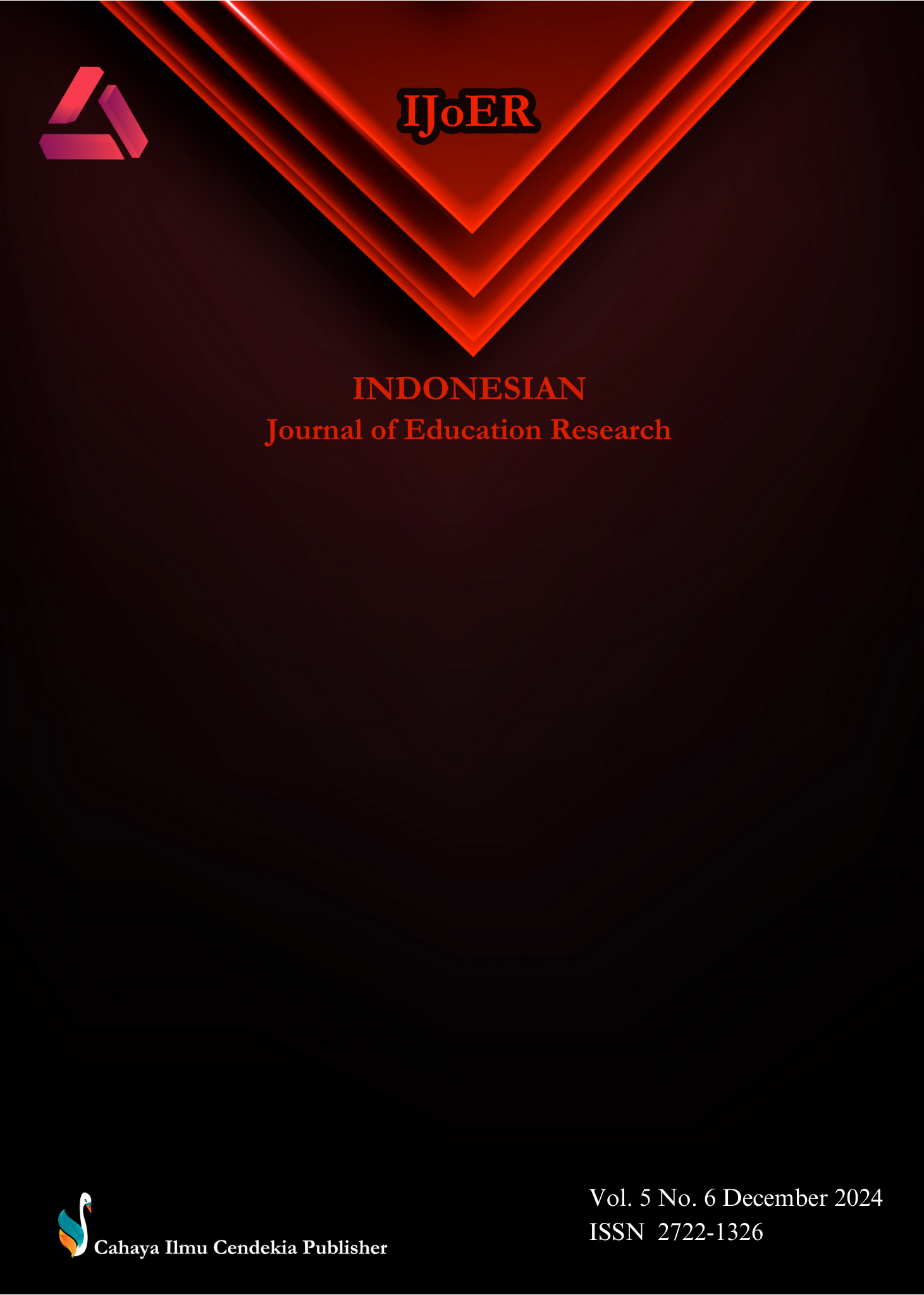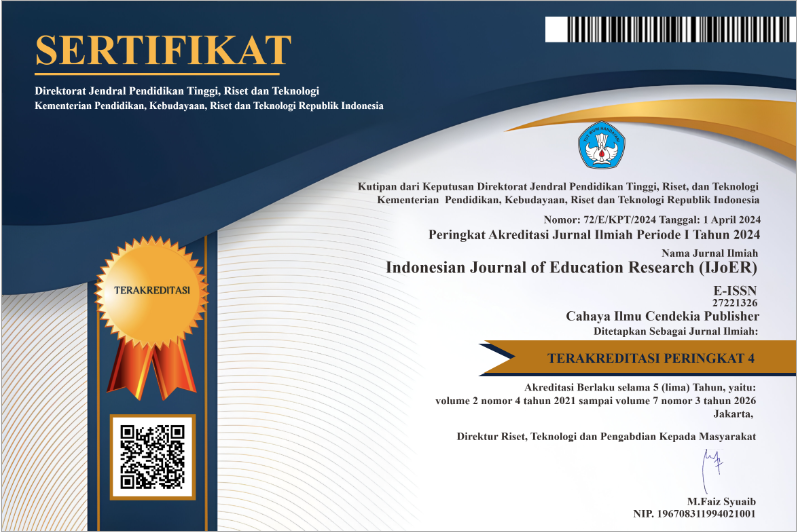The Similarity of Perceptions on Semester Learning Plan for General Course Environmental Study Based on Disaster Mitigation
Abstract
Purpose of the study: This study aims to analyze the disaster mitigation-based semester learning plan for the general course of living environment studies at Tadulako University.
Methodology: This is a descriptive qualitative study employing purposive sampling and survey methods using questionnaires. Data were analyzed through data reduction, data presentation, and conclusion drawing. Thirty respondents participated in the study.
Main Findings: Findings reveal that semester learning plan development indicators require seminars and workshops with experts, faculty, students, and alumni. The semester learning plan integrates disaster mitigation-oriented learning outcomes using case methods and team-based projects supported by field practice. semester learning plan implementation aligns with lecturers' improvisation, and periodic reviews are recommended every three years.
Novelty/Originality of this study: The study provides a framework for integrating disaster mitigation into the semester learning plan for general course of living environment studies, highlighting practical approaches like case methods and field projects. It advances the integration of disaster education into university-level environmental curricula.
References
N. Widyaningrum, A. P. Nurhadiyanti, and I. D. K. K. Widana, “The Importance of Disaster Knowledge in Early Childhood for The Future Investment,” Proceeding Int. Conf. Sci. Eng., vol. 3, no. April, pp. 605–609, 2020, doi: 10.14421/icse.v3.573.
L. N. Winarni, C. I. D. L. Dewi, A. A. G. Raka, and N. P. T. Widanti, “The Legal Politic in Countermeasure the Crime in Funding and Management of Disaster Assistance,” Sociol. Jurisprud. J., vol. 4, no. 1, pp. 31–38, 2021, doi: 10.22225/scj.4.1.2265.31-38.
R. Indonesia., Undang-Undang RI No. 32 Tahun 2009 Perlindungan dan Pengelolaan Linkungan Hidup. 2009.
N. Chaidir, M. Muhibbin, and H. Arief, “Juridical Analysis of Criminal Acts in Environmental Pollution in Accordance to the 32 Law of 2009 Concerning Protection and Management Environment,” Int. J. Law, Environ. Nat. Resour., vol. 4, no. 1, pp. 45–67, 2024, doi: 10.51749/injurlens.v4i1.58.
N. A. Mohidem and Z. Hashim, “Integrating Environment with Health: An Islamic Perspective,” Soc. Sci., vol. 12, no. 6, 2023, doi: 10.3390/socsci12060321.
D. Huang et al., “Microplastics and nanoplastics in the environment: Macroscopic transport and effects on creatures,” J. Hazard. Mater., vol. 407, p. 124399, 2021, doi: 10.1016/j.jhazmat.2020.124399.
C. Guida and G. Carpentieri, “Quality of life in the urban environment and primary health services for the elderly during the Covid-19 pandemic: An application to the city of Milan (Italy),” Cities, vol. 110, p. 103038, 2021, doi: 10.1016/j.cities.2020.103038.
M. A. Abdelhafiz et al., “Chemical and bacterial quality monitoring of the Nile River water and associated health risks in Qena–Sohag sector, Egypt,” Environ. Geochem. Health, vol. 43, no. 10, pp. 4089–4104, 2021, doi: 10.1007/s10653-021-00893-3.
Z. Fang, Y. Lin, C. Chen, J. Jiang, and L. Dong, “Mental health in China: exploring the impacts of built environment, work environment, and subjective perception,” Front. Psychol., vol. 15, no. February, pp. 1–12, 2024, doi: 10.3389/fpsyg.2024.1352609.
M. L. Marco et al., “The International Scientific Association for Probiotics and Prebiotics (ISAPP) consensus statement on fermented foods,” Nat. Rev. Gastroenterol. Hepatol., vol. 18, no. 3, pp. 196–208, 2021, doi: 10.1038/s41575-020-00390-5.
R. Reyes-Riveros, A. Altamirano, F. De La Barrera, D. Rozas-Vásquez, L. Vieli, and P. Meli, “Linking public urban green spaces and human well-being: A systematic review,” Urban For. Urban Green., vol. 61, no. March, 2021, doi: 10.1016/j.ufug.2021.127105.
K. S. Uralovich et al., “A primary factor in sustainable development and environmental sustainability is environmental education,” Casp. J. Environ. Sci., vol. 21, no. 4, pp. 965–975, 2023.
D. T. K. Ng, J. K. L. Leung, J. Su, R. C. W. Ng, and S. K. W. Chu, “Teachers’ AI digital competencies and twenty-first century skills in the post-pandemic world,” Educ. Technol. Res. Dev., vol. 71, no. 1, pp. 137–161, 2023, doi: 10.1007/s11423-023-10203-6.
O. Tapalova and N. Zhiyenbayeva, “Artificial Intelligence in Education: AIEd for Personalised Learning Pathways,” Electron. J. e-Learning, vol. 20, no. 5, pp. 639–653, 2022, doi: 10.34190/ejel.20.5.2597.
A. Syakur, S. Sugirin, M. Margana, E. Junining, and Y. Sabat, “Improving English Language Speaking Skills Using ‘Absyak’ On-Line Learning Model for Second Semester in Higher Education,” Budapest Int. Res. Critics Linguist. Educ. J., vol. 3, no. 2, pp. 684–694, 2020, doi: 10.33258/birle.v3i2.897.
I. Makruf, A. A. Rifa’i, and Y. Triana, “Moodle-based online learning management in higher education,” Int. J. Instr., vol. 15, no. 1, pp. 135–152, 2022, doi: 10.29333/iji.2022.1518a.
M. S. Sitepu, M. A. Maarif, A. Basir, A. Aslan, and A. Pranata, “Implementation of Online Learning in Aqidah Akhlak Lessons,” AL-ISHLAH J. Pendidik., vol. 14, no. 1, pp. 109–118, 2022, doi: 10.35445/alishlah.v14i1.1401.
M. Fahrurrozi, H. Wathoni, H. Basri, M. Mohzana, and A. Dwimaulani, “Entrepreneurial Leadership Values in Tourism Classroom Teaching. Enhancing the Learning Processes for Tourism Business,” J. Environ. Manag. Tour., vol. 2, no. 66, pp. 458–468, 2021.
S. Hartini, “Analisis Sinkronitas Rencana Pembelajaran Semester (RPS) Dengan Rencana Tugas Semester Mahasiswa (RTM) Dan Rencana Evaluasi Pembelajaran (REP) Dosen Fkip Unisri Tahun 2018,” Ejurnal Unisri, vol. 3(1): 608-, 2019.
S. Suharsono, O. S. Simanjuntak, R. I. Perwira, S. Pambudi, M. Fachrurradjie, and Y. P. Aqillasari, “Development of a Semester Learning Plans System based on OBE (Outcome-Based Education),” in Proceedings of the 2nd International Conference on Advanced Research in Social and Economic Science (ICARSE 2023), Atlantis Press SARL, 2024, pp. 485–501. doi: 10.2991/978-2-38476-247-7_51.
N. Erlina, I. N. Suardana, I. Wicaksono, and P. Pandiangan, “Education for sustainable development-based lesson plan validity test for mastery of pre-service science teacher learning outcomes,” J. Educ. Gift. Young Sci., vol. 10, no. 1, pp. 85–97, 2022, doi: 10.17478/jegys.1055967.
A. Z. Rahman, “Kajian Mitigasi Bencana Tanah Longsor Di Kabupaten Banjar Negara.,” 2015, vol. 29(1)..
A. A. Shah et al., “Identifying obstacles encountered at different stages of the disaster management cycle (DMC) and its implications for rural flooding in Pakistan,” Front. Environ. Sci., vol. 11, no. March, pp. 1–14, 2023, doi: 10.3389/fenvs.2023.1088126.
M. D. N. Ri, Keputusan Menteri Dalam Negeri Tentang Pedoman Penanggulangan Bencana Dan Penanganan Pengungsi Di Daerah Menteri Dalam Negeri No. 131.
I. Triastari, S. I. A. Dwiningrum, and S. H. Rahmia, “Developing Disaster Mitigation Education with Local Wisdom: Exemplified in Indonesia Schools,” in IOP Conference Series: Earth and Environmental Science, 2021, pp. 1–11. doi: 10.1088/1755-1315/884/1/012004.
E. P. Raharjo, S. Sarjana, and M. Safitri, “Transportation infrastructure planning in supporting disaster mitigation: Case study in Mount Gamalama,” Jamba J. Disaster Risk Stud., vol. 14, no. 1, pp. 1–11, 2022, doi: 10.4102/jamba.v14i1.1123.
Emosda, Lela, and Fadzlul., “Mengkonstruk Pemahaman Masyarakat Peduli Bencana Alam Banjir.,” J. Pengabdi. Masyarakat, vol. 29 (3)., 2014.
D. Tufekci-Enginar, M. L. Suzen, and A. C. Yalciner, “The evaluation of public awareness and community preparedness parameter in GIS-based spatial tsunami human vulnerability assessment (MeTHuVA),” Nat. Hazards, vol. 105, no. 3, pp. 2639–2658, 2021, doi: 10.1007/s11069-020-04416-8.
M. Kumasaki and M. King, “Three cases in Japan occurred by natural hazards and lessons for Natech disaster management,” Int. J. Disaster Risk Reduct., vol. 51, no. August, p. 101855, 2020, doi: 10.1016/j.ijdrr.2020.101855.
Bupati Karanganyar., Peraturan Bupati Karanganyar tentang Penetapan Status dan Tingkat Kedaruratan Bencana di Karanganyar. 2016.
R. S. Oktari, K. Munadi, R. Idroes, and H. Sofyan, “Knowledge management practices in disaster management: Systematic review,” Int. J. Disaster Risk Reduct., vol. 51, no. August, p. 101881, 2020, doi: 10.1016/j.ijdrr.2020.101881.
R. B. Bouncken, Y. Qiu, N. Sinkovics, and W. Kürsten, “Qualitative research: extending the range with flexible pattern matching,” Rev. Manag. Sci., vol. 15, no. 2, pp. 251–273, 2021.
H. M. Levitt, Z. Morrill, K. M. Collins, and J. L. Rizo, “The methodological integrity of critical qualitative research: Principles to support design and research review.,” J. Couns. Psychol., vol. 68, no. 3, pp. 357–370, 2021, doi: 10.1037/cou0000523.
S. Diana and A. W. Zaini, “Nurturing Excellence: Leveraging Service Quality for Competitive Advantage in Islamic Boarding Schools,” J. Educ. Manag. Res., vol. 2, no. 1, pp. 13–28, 2023, doi: 10.61987/jemr.v2i1.280.
I. G. Sujana, A. A. G. P. Semadi, N. M. Suarningsih, E. Retnaningrum, R. Widyatiningtyas, and I. G. N. Santika, “The Strategic Role of Parents in Optimizing Character Education in Early Childhood in the Family Environment,” J. Obs. J. Pendidik. Anak Usia Dini, vol. 7, no. 3, pp. 3241–3252, 2023, doi: 10.31004/obsesi.v7i3.4563.
P. Karuru, P. Bundu, A. Anshari, and H. A. Gani, “Students Perception on Physics Learning Interactions,” Univers. J. Educ. Res., vol. 9, no. 5, pp. 1044–1054, 2021, doi: 10.13189/ujer.2021.090517.
U. Tadulako., “Pedoman Peraturan Akademik. Palu. UNTAD.,” J. Manaj. dan Kebijak. publik, 2020.
A. D. Matraeva, M. V. Rybakova, M. V. Vinichenko, A. A. Oseev, and N. V. Ljapunova, “Development of creativity of students in higher educational institutions: Assessment of students and experts,” Univers. J. Educ. Res., vol. 8, no. 1, pp. 8–16, 2020, doi: 10.13189/ujer.2020.080102.
N. M. Tri, P. D. Hoang, and N. T. Dung, “Impact of the industrial revolution 4.0 on higher education in Vietnam: challenges and opportunities,” Linguist. Cult. Rev., vol. 5, no. S3, pp. 1–15, 2021, doi: 10.21744/lingcure.v5ns3.1350.
S. Syaharuddin, M. Mutiani, M. R. N. Handy, E. W. Abbas, and J. Jumriani, “Putting transformative learning in higher education based on linking capital,” J. Educ. Learn., vol. 16, no. 1, pp. 58–64, 2022, doi: 10.11591/edulearn.v16i1.20373.
Copyright (c) 2024 Mohammad Jamhari, Raya Agni, Syech Zainal, Moh. Sabran

This work is licensed under a Creative Commons Attribution 4.0 International License.
Authors who publish with this journal agree to the following terms:
- Authors retain copyright and acknowledge that the Indonesian Journal of Education Research (IJoER) is the first publisher licensed under a Creative Commons Attribution 4.0 International License.
- Authors are able to enter into separate, additional contractual arrangements for the non-exclusive distribution of the journal's published version of the work (e.g., post it to an institutional repository or publish it in a book), with an acknowledgment of its initial publication in this journal.
- Authors are permitted and encouraged to post their work online (e.g., in institutional repositories or on their website) prior to and during the submission process, as it can lead to productive exchanges and earlier and greater citation of published work.







.png)
.png)




















